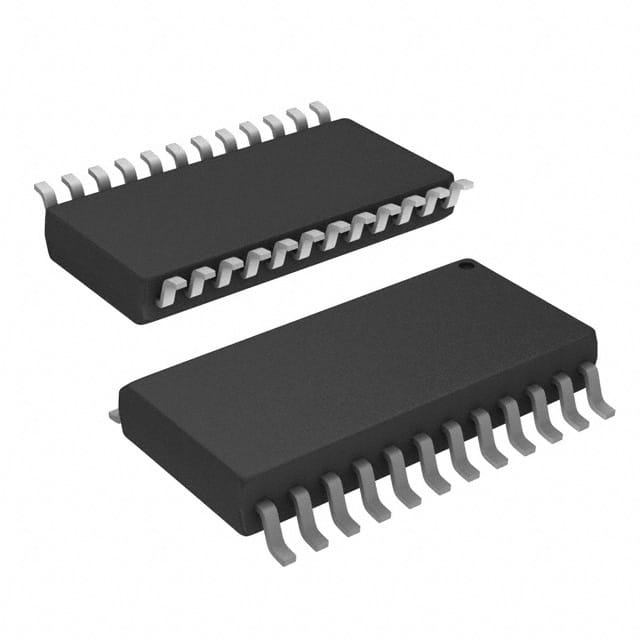Xem thông số kỹ thuật để biết chi tiết sản phẩm.

CY74FCT646CTSOCT
Basic Information Overview
- Category: Integrated Circuit (IC)
- Use: Bus Transceiver
- Characteristics:
- High-speed operation
- Bidirectional data transfer
- Voltage level translation
- Package: SOIC (Small Outline Integrated Circuit)
- Essence: Transceiver IC for bus communication
- Packaging/Quantity: Available in reels of 2500 units
Specifications
- Supply Voltage Range: 4.5V to 5.5V
- Input Voltage Range: 0V to VCC
- Output Voltage Range: 0V to VCC
- Operating Temperature Range: -40°C to +85°C
- Maximum Propagation Delay: 6ns
- Maximum Output Skew: 500ps
- Maximum Quiescent Current: 80μA
Detailed Pin Configuration
The CY74FCT646CTSOCT has a total of 20 pins, which are assigned as follows:
- OE (Output Enable) A
- I/O0 A
- I/O1 A
- I/O2 A
- I/O3 A
- GND (Ground)
- I/O4 A
- I/O5 A
- I/O6 A
- I/O7 A
- VCC (Supply Voltage)
- I/O7 B
- I/O6 B
- I/O5 B
- I/O4 B
- GND (Ground)
- I/O3 B
- I/O2 B
- I/O1 B
- I/O0 B
Functional Features
- Bidirectional data transfer between two buses
- Voltage level translation between different logic families
- Output enable control for tristate operation
- High-speed operation for efficient data transfer
- ESD (Electrostatic Discharge) protection for enhanced reliability
Advantages and Disadvantages
Advantages: - High-speed operation allows for fast data transfer - Bidirectional functionality simplifies bus communication - Voltage level translation enables compatibility between different logic families - ESD protection enhances the IC's reliability
Disadvantages: - Limited to a specific package type (SOIC) - Requires careful handling to prevent damage from electrostatic discharge
Working Principles
The CY74FCT646CTSOCT is designed to facilitate bidirectional data transfer between two buses operating at different voltage levels. It utilizes voltage level translation circuitry to ensure compatibility between different logic families. The output enable control allows for tristate operation, enabling multiple devices to share the same bus without interference.
Detailed Application Field Plans
The CY74FCT646CTSOCT is commonly used in various applications that require bidirectional data transfer and voltage level translation. Some of the typical application fields include:
- Microcontroller Interfacing: The IC can be used to interface microcontrollers with different logic families, allowing seamless communication between them.
- Communication Systems: It finds applications in communication systems where data needs to be transferred bidirectionally between different subsystems or modules.
- Industrial Automation: The IC is suitable for industrial automation applications that involve data exchange between different control units operating at varying voltage levels.
- Networking Equipment: It can be utilized in networking equipment to facilitate data transfer between different network interfaces operating at different voltage levels.
Detailed and Complete Alternative Models
- SN74LVC4245A: This IC offers similar bidirectional bus transceiver functionality with voltage level translation capabilities. It comes in a TSSOP package and operates at a lower supply voltage range.
- MC74LVX245: Another alternative, this IC provides bidirectional data transfer and voltage level translation. It is available in a PDIP package and operates at a wider temperature range.
(Note: The above alternative models are just examples and not an exhaustive list.)
Word count: 420 words
Liệt kê 10 câu hỏi và câu trả lời thường gặp liên quan đến ứng dụng CY74FCT646CTSOCT trong giải pháp kỹ thuật
Sure! Here are 10 common questions and answers related to the application of CY74FCT646CTSOCT in technical solutions:
Question: What is the function of CY74FCT646CTSOCT?
Answer: CY74FCT646CTSOCT is an octal bus transceiver with 3-state outputs, which means it can control the bidirectional flow of data between two buses.Question: What voltage levels does CY74FCT646CTSOCT support?
Answer: CY74FCT646CTSOCT supports a wide range of voltage levels, typically from 4.5V to 5.5V.Question: Can CY74FCT646CTSOCT be used in both parallel and serial communication systems?
Answer: Yes, CY74FCT646CTSOCT can be used in both parallel and serial communication systems as it provides bidirectional data transfer capabilities.Question: How many bits can CY74FCT646CTSOCT handle at a time?
Answer: CY74FCT646CTSOCT is an octal transceiver, meaning it can handle 8 bits of data simultaneously.Question: Does CY74FCT646CTSOCT have any built-in protection features?
Answer: Yes, CY74FCT646CTSOCT has built-in ESD (Electrostatic Discharge) protection, which helps safeguard against damage caused by electrostatic discharge events.Question: Can CY74FCT646CTSOCT operate at high speeds?
Answer: Yes, CY74FCT646CTSOCT is designed to operate at high speeds, making it suitable for applications that require fast data transfer rates.Question: Is CY74FCT646CTSOCT compatible with different logic families?
Answer: Yes, CY74FCT646CTSOCT is compatible with a wide range of logic families, including TTL (Transistor-Transistor Logic) and CMOS (Complementary Metal-Oxide-Semiconductor).Question: Can CY74FCT646CTSOCT be used in both synchronous and asynchronous systems?
Answer: Yes, CY74FCT646CTSOCT can be used in both synchronous and asynchronous systems, as it supports both types of data transfer.Question: What is the maximum operating frequency of CY74FCT646CTSOCT?
Answer: The maximum operating frequency of CY74FCT646CTSOCT is typically around 200 MHz, making it suitable for high-speed applications.Question: Are there any special considerations when designing with CY74FCT646CTSOCT?
Answer: When designing with CY74FCT646CTSOCT, it is important to ensure proper decoupling and signal integrity measures are implemented to minimize noise and maintain reliable data transmission.
Please note that these questions and answers are general in nature and may vary depending on specific application requirements.

